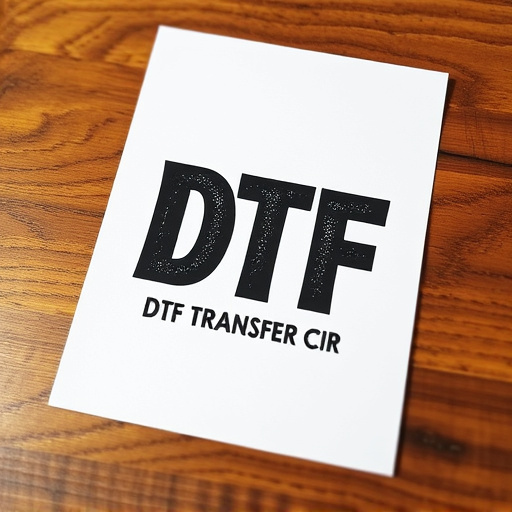Direct-to-Film (DTF) technology revolutionizes memory preservation by directly printing high-quality, durable images onto film. This process offers enhanced longevity compared to traditional methods, resisting fading, cracking, and wear from handling and washing. DTF prints are suitable for various applications, including art pieces, fashion, and archival purposes, ensuring vibrant colors and crisp details indefinitely. Proper care, such as using mild detergents and storing them away from direct sunlight and physical damage, extends the lifespan of these long-lasting transfers.
“Discover the revolutionary power of DTF Transfer technology, a game-changer in print and design. This article explores the comprehensive world of DTF, revealing how it surpasses traditional film transfers in durability and quality. From understanding the underlying technology to its diverse applications, we delve into the benefits and secrets behind long-lasting DTF Prints. Learn about the advanced materials and techniques ensuring resistance to wear and tear, making them ideal for various industries. Uncover best practices for maintaining these exquisite prints, allowing you to preserve their vibrancy for years.”
- Understanding DTF Transfer Technology: A Comprehensive Overview
- Advantages of DTF Prints Over Traditional Film Transfers
- Materials and Techniques Used in Creating Long-lasting DTF Transfers
- Ensuring Durability: Washing and Wear Resistance in DTF Printing
- Applications and Industries Benefiting from DTF Transfer Technology
- Best Practices for Maintaining and Caring for DTF Prints
Understanding DTF Transfer Technology: A Comprehensive Overview

The Direct-to-Film (DTF) transfer process is a groundbreaking technology revolutionizing the way we preserve and share memories. This innovative method allows for high-quality, long-lasting prints directly onto film, offering an unparalleled level of durability and resistance to fading. By eliminating the need for traditional printing methods, DTF provides a game-changing solution for creating permanent keepsakes from cherished photographs and films.
DTF Printing involves a precise and intricate process where custom designs or images are burned directly into specialized transparent film. This film is then treated with a chemical coating that enables it to transfer the image onto various media, such as cotton, polyester, or even other types of film. The result is a vibrant, permanent print with exceptional clarity and color accuracy, ensuring that cherished memories remain intact for generations. This technology’s resistance to washing and wear makes it an ideal choice for creating durable mementos, art pieces, and even fashion items featuring personalized DTF prints.
Advantages of DTF Prints Over Traditional Film Transfers

DTF (Direct-to-Film) prints offer several advantages over traditional film transfers when it comes to longevity and durability. The process involves printing directly onto the surface of a transparent film, creating a bond that is resistant to fading, cracking, and chipping. This makes DTF Transfers ideal for applications where the image needs to remain intact for extended periods, such as in archives, museums, or even personal collections.
Compared to traditional transfers, DTF Prints provide superior resistance to both physical wear and environmental factors like washing and handling. The direct printing method encapsulates the image within the film, protecting it from abrasions and making it less susceptible to damage during cleaning or storage. This results in vibrant colors and crisp details that remain consistent over time, ensuring that cherished memories and historical artifacts are preserved for future generations.
Materials and Techniques Used in Creating Long-lasting DTF Transfers

The process of creating long-lasting DTF (Direct to Film) transfers involves a blend of cutting-edge materials and precise techniques. Manufacturers carefully select high-quality, durable substrates that can withstand rigorous washing processes without fading or peeling. These substrates are often treated with special coatings to enhance their resistance to moisture, chemicals, and UV rays, ensuring the vibrancy and longevity of DTF prints.
DTF printing utilizes advanced inkjet technology to precisely deposit inks onto the film surface. The inks used are designed to be fast-drying and highly pigmented, preventing smudging and ensuring the accuracy of colors in the final transfer. Additionally, a key step in the process is the application of protective laminates that seal the print, protecting it from environmental damage and extending its lifespan. These laminates also provide an extra layer of resistance against wear and tear, making DTF transfers a superior choice for long-term use.
Ensuring Durability: Washing and Wear Resistance in DTF Printing

Ensuring Durability: Washing and Wear Resistance in DTF Printing
When it comes to preserving cherished memories or creating long-lasting gifts, the quality of film transfers plays a pivotal role. One innovative technology gaining traction is Direct to Film (DTF) printing. DTF Transfers offer exceptional durability compared to traditional methods, making them resistant to wear and tear from everyday use. This enhanced longevity is particularly notable when subjected to regular washing processes, ensuring that prints remain vibrant and intact even after repeated launderings.
The secret behind DTF’s resilience lies in its advanced printing process. Unlike conventional methods, DTF directly applies ink to the film surface, creating a seamless bond. This construction prevents ink from fading or peeling over time, even under harsh conditions. Whether it’s a beloved family photo or a custom design, DTF prints boast a rich color palette and sharp details that stand the test of time and frequent handling, making them ideal for everything from framing to everyday use items.
Applications and Industries Benefiting from DTF Transfer Technology

The DTF Transfer technology has found its way into various industries, revolutionizing how products are designed and produced. Its applications span across multiple sectors, from apparel to signage, offering durable and high-quality solutions. In the fashion industry, for instance, DTF Printing enables custom textile designs with vibrant colors and intricate details that resist fading and washing, ensuring garments maintain their aesthetic appeal over time.
Moreover, industries requiring long-lasting branding and promotional materials greatly benefit from DTF. Signage manufacturers can create durable outdoor signs and banners with robust prints capable of withstanding environmental elements, making them ideal for businesses seeking visibility. Similarly, product packaging designers can now incorporate DTF Prints to enhance brand identity while ensuring product information remains legible and visually appealing even after prolonged storage or transportation.
Best Practices for Maintaining and Caring for DTF Prints

Caring for DTF (Direct to Film) transfers is a straightforward process when following best practices. To ensure longevity, avoid harsh cleaning agents and abrasive materials that can damage the delicate print surface. A gentle hand wash with a mild detergent and warm water is recommended for cleaning. Always air dry your DTF prints to prevent any potential warping or color fading caused by heat exposure.
Regular handling with care is paramount. Store DTF prints in a clean, dry environment away from direct sunlight to safeguard against color degradation. Consider framing or mounting them properly to avoid physical wear and tear. Additionally, keeping them out of reach of children and pets will further extend their lifespan, preserving the vibrant images for years to come.














